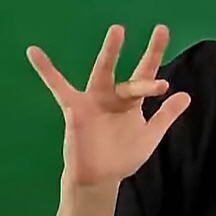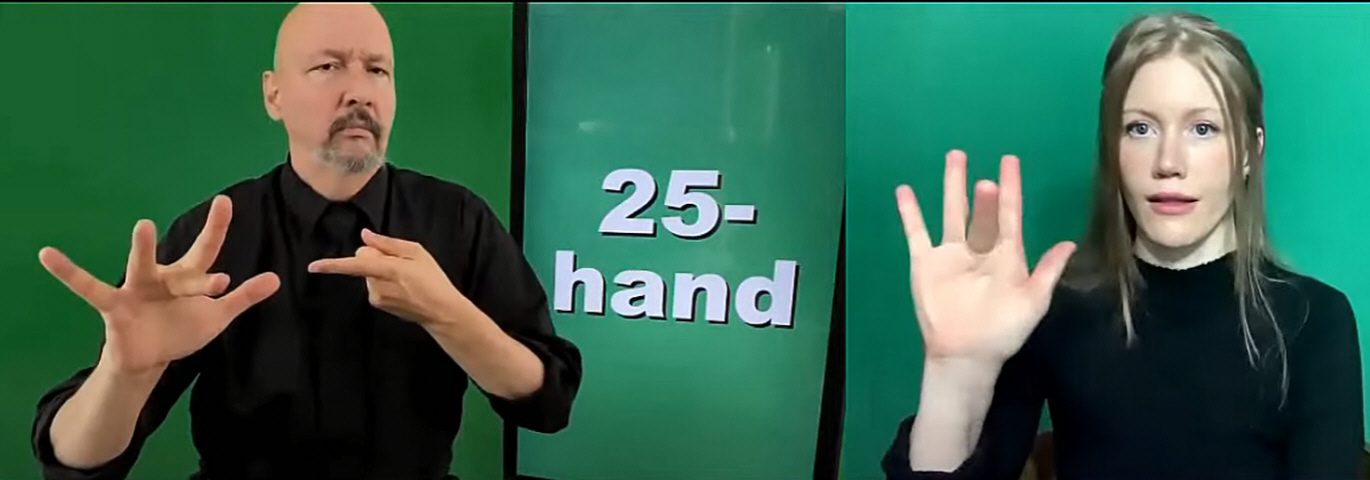25-hand / open-8 / bent-middle-finger-hand / classifier-25
(cl-25, cl:25, cl-open-8, classifier:open-8)


When is a sign a classifier and when is it not?
Suppose a student asks, "What might qualify or disqualify
"EMPTY-["empty-shelves"]-[context:_previously-identified-shelves]" as a
"depictive" sign (formerly known as "classifier")?
What characteristics of the sign or its usage allow us to claim that it is a
classifier any more than perhaps the sign
BALD-[25-handshape-circles-top-of-head-version]?
The sign BALD uses the "EMPTY" sign to indicate that the top of the head is
empty of hair.
The sign BALD is generally not regarded as a "depictive" sign (classifier).
The sign BALD, in its dictionary citation form, is typically regarded as
"just a regular sign."
Signs in ASL have a spectrum of usability:
1. Plain signs in which the location is articulatory and doesn't
specifically influence the meaning. If I sign RIGHT-[correct] by whacking the
pinkie-side-of-the-index-finger-handshape onto a table it doesn't mean "the
table is right." It means I have a sandwich in my non-dominant hand and I want
to sign "RIGHT" without mucking up my sandwich.
2. Indicating signs in which the orientation and/or direction and/or
movement of the sign convey information regarding the subject and/or the object
being discussed. An example of this is the sign "GIVE-me."
3. Locative signs in which the location of the sign is morphemic –
which is to say that where you do the sign conveys meaning. An example of this
is to sign PAIN near the side of the mouth to create a meaning of "toothache."
Thus we can say that the sign PAIN is "locative." The sign pain however is not a
"depictive" sign (not a classifier).
4. Depictive signs: When the handshape of the sign itself has meaning
(which is to say commonly associated in the mind with a specific type of person,
thing, or element) and/or is moved in such a way as to specify the size, shape,
or inherent nature of a person, thing, or element – that is when we can promote
a sign from the status of "indicating" and "locative" to instead being a
full-fledged "depictive sign" (formerly known as classifier).
Just because a handshape is sometimes used as a classifier doesn't automatically
qualify all uses of that handshape as being a classifier. A 5-hand with the
middle finger bent forward rarely "depicts" anything (in the sense that the
topic being discussed looks and functions nothing like a
bent-middlefinger-5-handshape).
The sign EMPTY is not a classifier. The sign BALD is not a classifier. The sign DEPRESSED is not a classifier. (They could be considered "former classifiers or fossilized classifiers though.)
Signs such as this-spot-is-EMPTY and horizontal-EMPTY are certainly locatives but are not in the same category as a classifier such as CL-1: "person walking."
In a phrase such as "SHELVES horizontal-EMPTY" the location of the sign
(being done in the location of the shelves) carries the meaning of "it is the
shelves that are empty."
Should we consider the "horizontal-EMPTY" sign to be a depictive sign?
Not in the sense of the handshape itself depicting an object but we could
perhaps think of the bent-middle-finger handshape as being capable (in context)
of being morphemic (with a meaning of "empty") when bound to other features
(movement, location, orientation, NMMs) in an the articulatory bundle.
The nature of the sign EMPTY is along the lines of "phonaesthesia" (wherein
in spoken languages particular sounds become associated with categories of
meaning but don't necessarily sound like the thing they are associated with).
There is a sub-category of depictive signing that is sometimes referred to as
"size and shape specifiers."
Horizontal-EMPTY could be considered depictive if you include size and shape
specification signs as a subcategory if "depictive signs." For example, a
person could sign SHELVES and then do the "horizontal-EMPTY" sign using a longer
than normal movement (and an exaggerated facial expression) or a non-standard
movement path to provide us additional information about the length or shape of
the shelves (not merely their emptiness). We could then consider the sign to be
functioning as a "size and shape specifier" type of depictive sign. This is
still tenuous (very weak or slight) though in that it is the beginning location,
movement path, and ending location (as well as the non-manual marker / facial
expression) that are (morphemic) creating the meaning of "long." The "handshape"
itself is still not providing us any specific information (regarding size or
shape) and thus is not in the same category of sign as for example an "A" hand
being used to represent a scalpel slicing a specific location during surgery.
The shape of the "A" hand tells us specific information about the nature of the
blade (it is small, has a sharp edge, and is not a machete).
The 25-handshape (as used in horizontal-EMPTY) itself tells us nothing about the size or shape of the shelves and thus it is only through the movement-distance that we can gather the (additional) meaning of "the shelf is really long." Thus horizontal-EMPTY is similar to the sign very-LARGE in that if we were to see it in isolation we would have no real concept of "what" is empty or "what" is large. Whereas if we were to view (what we traditionally consider to be) a depictive sign we would have some inkling of what type of thing it is. Using an extended movement with 25-handshape tells us "some unspecified person, thing, or element is long and empty." Using an extended movement with a true classifier-A handshape would give us the meaning of "a long cut with a small knife." Thus the "A" handshape when used as a classifier is more powerful (in terms of providing more specific information) than the EMPTY sign when (supposedly) used as a classifier.
Here is a variation of the horizontal-EMPTY sign: https://youtu.be/LKSFVxJr5lE
I would like to bring up a comparison. Consider the term "zero."
Is zero something? How do you depict nothing?
Well I can draw, write, or type a "0."
Most people would probably agree that "0" has a special role in the number
system as a way to depict "nothing" or the "absence of something."
I suggest to you that the EMPTY sign also has a special role (in ASL) and can be
used as a classifier-type depiction of "nothingness."
Are there times when a 25-hand definitely functions as a depictive sign? Yes. An example would be if you were discussing a "smoothie maker" (blender) and using the palm-up-25 sign to represent the whirling blade going faster or slower than normal – or breaking. The middle finger would literally be depicting (showing, representing) the size, shape, movement of the blade. (Note: If you were "not" specifically depicting some out of the normal happenstance with the "blade" then you would be using a fossilized classifier which can no longer be considered "acting as a depictive sign." (Sort of like the difference between a boxer and a former boxer. A former boxer can come out of retirement and move around in the ring but when they retire they just sit in one place and can't really be considered boxers anymore.) Also, for what it is worth I'd rather use my index finger to show the whirling blade.
For a video discussion of some uses of the 25-hand handshape, see the 13:35 time
code (thirteen minutes and 35 seconds point in the video) of the following
video:
https://youtu.be/9xAlr4T9LnQ?t=708
Notes:
index-old.htm
Reference: Linguistics of American Sign Language, 5th Ed. pp 133-143.
Also see:
Depictive Signing: Quick review of basic classifiers (ASL) with Dr. Bill Vicars of ASLU
Classifiers (page)
Classifiers (main)
*
Want to help support ASL University? It's easy:
DONATE (Thanks!)
* Another way to help is to buy something from Dr. Bill's "Bookstore."
* Want even more ASL resources? Visit the "ASL Training Center!" (Subscription
Extension of ASLU)
* Also check out Dr. Bill's channel:
www.youtube.com/billvicars
You can learn American Sign Language (ASL) online at American Sign Language University ™
ASL resources by Lifeprint.com © Dr. William Vicars
